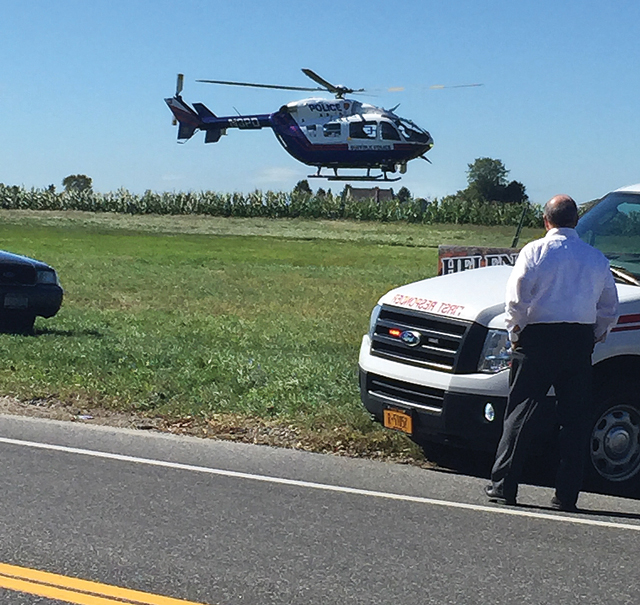Flown to safety: The process behind medevac flights


Suffolk County’s aviation unit was first launched in 1987, but medevac service to the North Fork was sped up with the introduction of a helicopter at Francis S. Gabreski airport in Westhampton in 2001. Previously, helicopters were only kept at Long Island MacArthur Airport in Ronkonkoma.
Although police helicopters are clearly beneficial, they’re not perfect. One downside is the cost of an emergency flight. While Suffolk County did not provide how much is billed to insurance companies locally, NBC News reported in 2009 that flights can cost up to $25,000 in some instances.
The cost to purchase helicopters can also be expensive for municipalities. Suffolk County spent $3.1 million in 2001 to purchase a helicopter, a cost that only covered the helicopter itself — not the staff, medicine, machines and jet fuel required to operate it.
A medevac also needs somewhere to land, a job that typically falls on the shoulders of the firemen or police officers at the scene.
“We usually have cookie-cutter areas around the town where we’ve used before and they’ve proven to be successful,” Chief Brooks said. “You want to land in areas free of wires, free of obstacles.”
Around Riverhead, these places include the County Center, the fire department’s training grounds on Northville Turnpike and County Route 105, their third substation in Calverton and sod farms, he said. In Southold Town, the local high schools, the Cutchogue Fire Department and Strawberry Fields are all common landing zone locations.
Even though there are locations that have been pre-determined as appropriate landing zones, they’re not the only places that can be used. Riverhead Town Police Chief David Hegermiller explained that landing zones are often chosen based on their proximity to the accident and can be anywhere deemed safe for the aircraft to land.
Additionally, if a helicopter is called, it doesn’t necessarily mean one will respond to an accident. Assistant Chief Richardson explained that helicopter pilots are first put on standby once an accident happens, allowing them to prepare for a flight. They’re then called once more, either confirming the need or canceling the medevac. This saves time, he said. When the definite “We need this” call is made, the pilot is all ready to go.
While the Suffolk County Police Department helicopters are best known for transporting critical patients from accidents, Chief Brooks and Southold Town Police Chief Martin Flatley said they are used for numerous other reasons, including responding to a home where someone is having a stroke and providing better vantage points for brush fires, car chases and missing persons cases.
“It’s invaluable,” Chief Flatley said. “You talk about that golden time frame that you have for a person that has a stroke or a heart attack or something [similar]; to get them to a trauma center like Stony Brook, it could never be achieved by use of ambulances. As far as from strictly a police perspective … The amount of times that we search for either boats out on the water or someone missing in fields, it gives us a great perspective and one that you can’t achieve any other way.”






